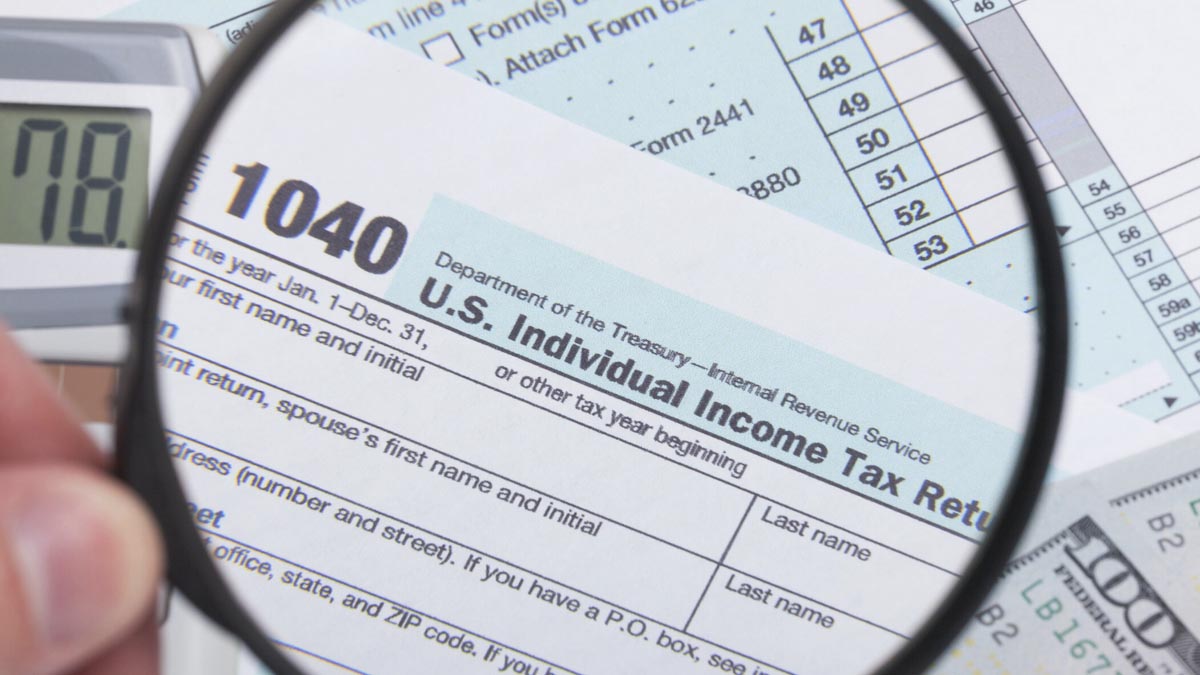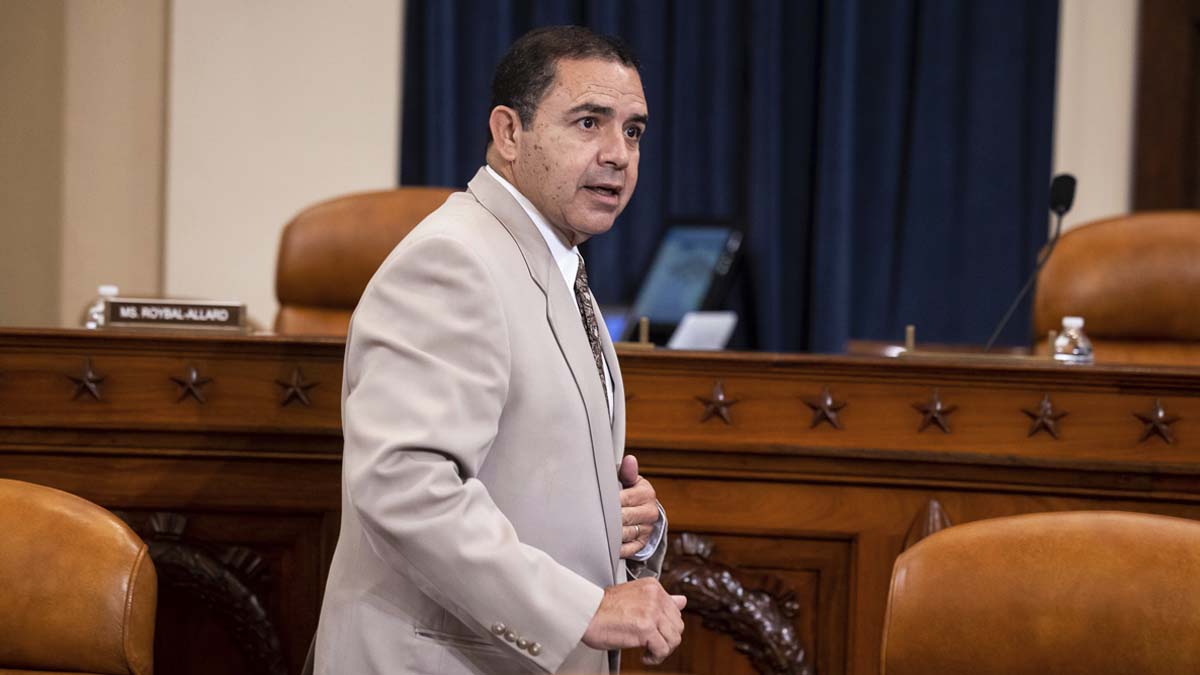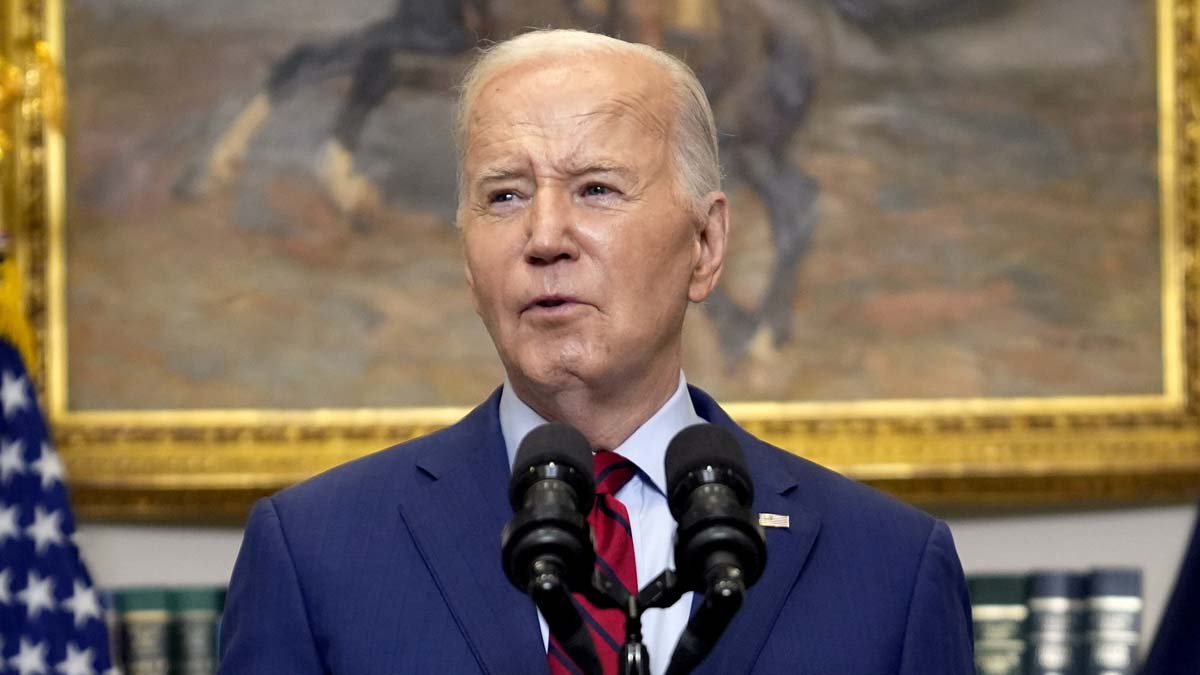
New 2024 Tax IRS Brackets Kick in on Jan. 1: Here’s Where You Fall
-


VIDEO: Trans Student Brutally Beats Much Smaller Girl in NY School’s Female Bathroom
-


CIA Contractor Claims Mike Pompeo, Staff Withheld Information from Trump
-


NYPD Storms Columbia to Clear Occupied Building — 100 Pro-Palestine Protesters Arrested
-


Islamist Extremists Attack & Burn Christian Homes in Egypt
The beginning of January brings with it new tax brackets that will let some Americans keep more of their income.
The changes stem from annual inflation adjustments by the Internal Revenue Service aimed at preventing workers who get raises from being pushed into higher tax brackets even though their purchasing power hasn’t changed.
The 5.4% adjustment for 2024 is smaller than the 7.1% increase in 2023, but it’s a bigger boost than the 3.1% change seen in 2022.
In some cases, the new tax brackets may mean taxpayers owe less to the IRS, even if they’ve made more money.
For example, someone who had a taxable income of $95,000 in 2023 and gets a 3% pay increase to $97,850 in 2024 would drop to a 22% bracket from 24%.
The top tax rate in 2024 remains 37% for single taxpayers with incomes greater than $609,350, or $731,200 for married couples filing jointly.
That’s up from 2023’s threshold of $578,125 for individuals or $693,750 for married couples filing jointly.
The other tax brackets for 2024 are:
- 35% tax rate for single taxpayers with income over $243,725 or $487,450 for married couples, up from $231,250/$462,500 last year
- 32% tax rate for people who earn over $191,950 or $383,900 for married couples, up from $182,100/$364,200 last year
- 24% tax rate people who earn over $100,525 or $201,050 for married couples, up from $95,375/$190,750 last year
- 22% tax rate for people who earn over $47,150 or $94,300 for married couples, up from $44,725/$89,450 last year
- 12% tax rate for people who earn over $11,600 or $23,200 for married couples, up from $11,000/$22,000 last year
- 10% tax rate for people who earn $11,600 or less, or $23,200 or less for married couples, up from $11,000/$22,000 last year
Standard deductions — the income you can shield from tax without itemizing — will increase next year by $750 to $14,600 for individuals, by $1,500 to $29,200 for married couples filing jointly, and by $1,100 to $21,900 for heads of household, the IRS said.
People who choose to itemize deductions will continue to have the “no limitation” rule stemming from Tax Cuts and Jobs Act, the IRS said in its Nov. 9 announcement about 2024’s inflation adjustments.

News
Dem Rep. Henry Cuellar and Wife Indicted on Federal Bribery Charges

The Justice Department on Friday released an indictment against longtime Rep. Henry Cuellar, D-Texas, and his wife, Imelda, charging the pair with bribery and money laundering related to their ties with a bank in Mexico and an oil and gas company controlled by Azerbaijan.
NBC News was first to report that the charges were coming. The congressman and his wife were each released on a $100,000 bond after a first appearance in federal court in Houston, a DOJ spokesperson said Friday afternoon.
According to the indictment, from 2014 to 2021, the Cuellars allegedly accepted roughly $600,000 in bribes from the two foreign entities in exchange for the congressman performing official acts.
“The bribe payments were allegedly laundered, pursuant to sham consulting contracts, through a series of front companies and middlemen into shell companies owned by Imelda Cuellar, who performed little to no legitimate work under the contracts,” the DOJ said in a statement.
“In exchange for the bribes paid by the Azerbaijani oil and gas company, Congressman Cuellar allegedly agreed to use his office to influence U.S. foreign policy in favor of Azerbaijan,” DOJ continued. “In exchange for the bribes paid by the Mexican bank, Congressman Cuellar allegedly agreed to influence legislative activity and to advise and pressure high-ranking U.S. Executive Branch officials regarding measures beneficial to the bank.”
The congressman and his wife are each charged with two counts of conspiracy to commit bribery of a federal official and to have a public official act as an agent of a foreign principal; two counts of bribery of a federal official; two counts of conspiracy to commit wire fraud; two counts of violating the ban on public officials acting as agents of a foreign principal; one count of conspiracy to commit concealment money laundering; and five counts of money laundering.
If convicted, they could spend years or even decades in prison.
In a statement Friday before the charges were unsealed, Cuellar denied any wrongdoing, saying that he had “proactively sought legal advice” from the House Ethics Committee, which had issued “more than one written opinion” about the matter. Much of his statement focused on his wife.
“I want to be clear that both my wife and I are innocent of these allegations. Everything I have done in Congress has been to serve the people of South Texas,” Cuellar said in his statement, later adding: “The actions I took in Congress were consistent with the actions of many of my colleagues and in the interest of the American people.”
“Imelda and I have been married for 32 years. On top of being an amazing wife and mother, she’s an accomplished businesswoman with two degrees. She spent her career working with banking, tax, and consulting,” he continued. “The allegation that she is anything but qualified and hard working is both wrong and offensive.”
A defiant Cuellar also made clear he will still seek re-election: “Let me be clear, I’m running for re-election and will win this November.”
A statement from the congressman’s defense attorneys was similar to Cuellar’s but also noted prosecutors indicted him just six months before Election Day.
“The government’s decision to move forward with charges so close to the general election — and their decision to execute a search warrant 40 days before his [2022] primary — undermines the electorate and puts a thumb on the scale,” said attorneys Chris Flood and Eric Reed.
House Minority Leader Hakeem Jeffries, D-N.Y., and other top Democratic leaders had endorsed Cuellar’s re-election bid last summer. In a statement, Jeffries spokesperson Christie Stephenson called Cuellar a “valued Member of the House Democratic Caucus,” noting that Cuellar is “entitled to his day in court and the presumption of innocence throughout the legal process.”
In the meantime, Cuellar will step aside from his position as the top Democrat on the House Appropriations subcommittee overseeing the Department of Homeland Security, Stephenson said.
Cuellar’s home and campaign office in Laredo, Texas, were raided in January 2022 as part of a federal investigation into Azerbaijan and a group of U.S. businessmen who have ties to the country, law enforcement said at the time. His office had pledged to cooperate with the investigation. In April, Cuellar’s lawyer, Joshua Berman, told some news outlets that federal authorities informed him he was not the target of the investigation.
Cuellar is a one-time co-chair of the Congressional Azerbaijan Caucus. According to the indictment, in exchange for the bribes, Cuellar promised to influence legislation related to Azerbaijan’s conflict with neighboring Armenia; insert pro-Azerbaijan language into legislation and committee reports on security and economic aid programs; deliver a pro-Azerbaijan speech on the House floor; and “consult” with Azerbaijan officials about their efforts to lobby the U.S. government.
Ahead of the indictment’s release, Cuellar’s staff were calling other member offices Friday seeking advice on how to handle the situation, one source with knowledge of those calls told NBC News.
A year after the raid on his home — which has not previously yielded arrests or charges — Cuellar told the Texas Tribune: “There has been no wrongdoing on my part. … My focus remains the same from my very first day in office: delivering results for Texans across my district.”
Despite the raid, Cuellar narrowly defeated a progressive challenger, Jessica Cisneros, in his 2022 primary and went on to win re-election to his seat that November. He didn’t face a primary challenger this year and will be on the ballot this November seeking his 11th term in Congress.
Two years ago, Cuellar easily defeated Republican nominee Cassy Garcia, 57% to 43%. His district became bluer when he picked up parts of San Antonio following redistricting. But the indictment will make Cuellar more vulnerable than in the past; in 2020, Joe Biden won Cuellar’s district over Donald Trump by 7 percentage points.
Two Republicans will face each other in a runoff election in late May for a chance to take on Cuellar in the fall.
“Henry Cuellar does not put Texas first, he puts himself first,” said Delanie Bomar, a spokesperson for the National Republican Congressional Committee. “If his colleagues truly believe in putting ‘people over politics,’ they will call on him to resign. If not — they are hypocrites whose statements about public service aren’t worth the paper they’re written on.”
Cuellar is facing a call to resign from a member of his own party, Rep. Dean Phillips, D-Minn., who said in a post to X on Friday night that “while the bar for Federal indictment is high, trust in our government is low.”
“That’s why office holders and candidates under indictment should resign or end their campaigns, including Sen. Bob Menendez, Donald Trump, & Rep. Henry Cuellar,” Phillips, who was among the first to call on Menendez to resign, continued.
Cuellar, 66, a lawyer, is a former customs broker and Texas secretary of state. A member of the centrist Blue Dogs and New Democrat Coalition, Cuellar was elected to the House in 2004.
He’s the only Democrat left in Congress who opposes abortion rights — a position that has infuriated many in his party.
The Cuellars are the second congressional couple to be charged in a foreign bribery scheme in the past year. In September, DOJ charged then-Senate Foreign Relations Chairman Bob Menendez, D-N.J., and his wife after they allegedly accepted hundreds of thousands of dollars, including gold bars, in return for official acts aimed at enriching three New Jersey businessmen and benefitting the Egyptian government. Both Cuellar and Menendez are members of the Congressional Hispanic Caucus.
Menendez, who stepped aside from leading Foreign Relations, has pleaded not guilty. His trial is scheduled to begin later this month.
A third lawmaker, New York Republican George Santos, was expelled from the House in December after a scathing ethics report and 23-count federal indictment charging him with crimes such as wire fraud and money laundering. Santos also has pleaded not guilty.
News
Tearful Hope Hicks Testifies That Trump Was Trying to Protect His Family

Donald Trump’s former top aide Hope Hicks broke down on the witness stand Friday at his hush money trial, during testimony where she also defended the former president’s relationship with wife Melania.
Hicks, 35 — former press secretary then top White House spokesperson to the ex-president — began crying after the first few questions by Emil Bove, a lawyer for the presumptive Republican presidential nominee.
During the emotional moment Hicks dabbed her eyes with a tissue as Manhattan Supreme Court Justice Juan Merchan offered her a short break, which she accepted.
Althought it is not clear why she started to cry, Hicks had first become visibly flustered at the end of questioning by the prosecution, while answering questions about the $130,000 payment to porn star Stromy Daniels which is at the center of the trial.
She had testified she thought Trump thought felt “it was better to be dealing” with the situation in 2018 than before the 2016 presidential election.
Hicks also choked up when she got back on the witness stand while recalling her time working for the Trump Organization.
Hicks had been on the stand for roughly four hours displaying composure while prosecutors grilled her on her time working for the ex-president beginning in 2015 and ending in 2022 — which she said is the last time she saw him.
Earlier, Hicks told jurors how Trump tried to ensure a Wall Street Journal article from Nov. 4, 2016 detailing allegations of an affair with Playboy Playmate Karen McDougal wouldn’t be seen by Melania.
“He was concerned about the story. He was concerned how it would be viewed by his wife,” Hicks said. “And he wanted to make sure the newspapers weren’t delivered to his residence that morning.”
Later, during follow-up by Bove, Hicks explained the reason Trump didn’t want Melania to see the McDougal article was because of how much he cares and respects her.
“President Trump really values Mrs. Trump’s opinion and she doesn’t weigh in all the time but when she does it’s really meaningful to him,” Hicks said.
“He really, really respects what she has to say. I think he was really concerned about what the perception of this would be and, yeah, I know that was weighing on him.”
Hicks added Trump didn’t want anyone from his family to “be hurt” by stories that were “going on in his campaign.”
Trump wished Melania a happy birthday from the courthouse last week while she was in Florida. She has not attended the first two weeks of trial.
Hicks — a former teen model, who admitted to having no experience before coming onto Trump’s team — also took a jab at Trump’s former lawyer Michael Cohen, who is expected to be the star prosecution witness against his longtime boss.
“He liked to call himself a fixer, or Mr. Fix It,” Hicks said.
“It’s only because he first broke it so he could fix it,” she added, to chuckles from the courtroom.
Earlier, Hicks laid out how Cohen was very involved in Trump’s media response denying the allegations of his affair with McDougal.
She explained that Cohen “wasn’t supposed to be on the campaign in any official capacity,” but he tried to “insert himself” anyway.
Cohen “wasn’t looped in on the day-to-day of campaign strategy” Hicks said of Cohen, adding he would go “rogue” and would do things that frustrated the campaign.
Hicks’ testimony wrapped later Friday afternoon.
Trump is on trial for allegedly falsifying business records to try to hide that he had Cohen paid Daniels $130,000 in the run-up to the 2016 election to keep her quiet about claims she had slept with Trump while he was married. He has pleaded not guilty to 43 charges of falsigying business records realted to the payment.
He’s repeatedly attacked the trial as political motivated meant to interfere with his election bid.
Leaving the court he railed against Manhattan DA Alvin Bragg and the Department of Justice.
“They’ve been after us for years — Democrats, the radical left — they’ve destroyed people’s lives.
“It’s a shame what they’ve done to this country. … These are vicious, vicious radical left lunatics,” he added.
The trial is set to resume with a new witness Monday morning.
News
VIDEO: Trans Student Brutally Beats Much Smaller Girl in NY School’s Female Bathroom

Shocking video showing a ‘transgender’ student attacking another girl in a women’s restroom resulted in a bomb threat being sent to the school after the clip went viral.
The assault at Greece Arcadia high school took place in February and saw the victim dragged out of a stall by her hair by a much larger attacker, described as transgender.
Footage of the attack was shared by feminist website Reduxx on Thursday and resulted in a bomb threat being sent to the school, forcing it to close on Friday.
Greece Central School District Superintendent Kathleen Graupman said the anonymous threat qualifies as a ‘hate crime’ as she slammed those using the video to further ‘hateful’ agendas.
The clip in question shows a student barge into a restroom stall and begin beating a girl inside while other pupils film on their phones.
The student grabs the screaming girl by her hair and drags her out along the floor and into the hallway.
The student throws several more punches before a member of staff comes running over to separate them.
Even as they are dragged away, the assailant refuses to let go of the girl’s hair.
Eventually the student is escorted away and the girl who was attacked runs up behind and attempts to fight back.
However, she is picked up and carried away by what appears to be another staff member.
In the wake of the footage going viral on Thursday, the school was sent a bomb threat at 6.07am on Friday.
🚨A girl was reportedly assaulted in the female restroom at Arcadia High School in Rochester, New York.
According to another student at the school, the attacker is a boy who identifies as a girl. He was allegedly retaliating for perceived insults.
Reduxx reached out to Greece… pic.twitter.com/f7Mt0AZfT6
— REDUXX (@ReduxxMag) May 2, 2024
Several bus loads of students who had already arrived on campus had to be redirected as cops worked to investigate.
The threat accused the school of failing to make a safe learning environment and accused the district of encouraging ‘mentally ill’ and ‘degenerate’, making reference to the fight, NBC News10 reports.
‘They created a situation that allowed for a girl to be assaulted in a women’s restroom by a worthless degenerate sack of mentally ill who thinks he’s a girl,’ the threat said.
‘We’re here to send a message, we placed a bomb in the school, evacuate now.’
There has been no confirmation from official sources about any of the students’ gender identity.
However, Reduxx stated it had spoken to another student at the school who claimed the attacker is transgender.
‘It is clear that this is being used for an agenda, whether it’s a personal or political agenda, it is being used,’ Graupman said.
‘That fight that occurred was significant and very, very upsetting and disturbing, and also I want to be very clear it involved minors, it involved minors that deserve respect and privacy.
‘We don’t get to share videos and names and peoples personal identities out there.’
Graupman did not say what measures had been taken to discipline the attacking student in the wake of the fight.
The police eventually deemed that the threat was not credible and the school reopened after 9am.
New York is among states whose laws let transgender people use whichever bathroom aligns with their gender identity.
Supporters of the law say it helps enshrine the dignity of trans people, who are often vulnerable to abuse and attacks.
Detractors say it can threaten women’s safety, by allowing men who decide to self-identify as transgender to access female-only spaces.
News
Biden Awards Medal of Freedom to Nancy Pelosi, Al Gore and 15 Others

President Joe Biden on Friday bestowed the Presidential Medal of Freedom on 19 people, including civil rights icons such as the late Medgar Evers, prominent political leaders such as former House Speaker Nancy Pelosi and Rep. James Clyburn, and actor Michelle Yeoh.
Biden said the recipients of the nation’s highest civilian honor are “incredible people whose relentless curiosity, inventiveness, ingenuity and hope have kept faith in a better tomorrow.”
One of them, Clarence B. Jones, said in an interview that he thought a prankster was on the phone when he answered and heard the caller say they were from the White House.
“I said, ‘Is this a joke or is this serious?’” Jones recalled. The caller swore they were serious and was calling with the news that Biden wanted to recognize Jones with the medal.
Jones, 93, was honored for his activism during the Civil Rights Movement. He’s a lawyer who provided legal counsel to Martin Luther King Jr. and helped write the opening paragraphs of the “I Have a Dream” speech that King delivered at the Lincoln Memorial at the 1963 March on Washington.
The White House said the recipients are “exemplary contributions to the prosperity, values, or security of the United States, world peace, or other significant societal, public or private endeavors.”
The 10 men and nine women hail from the worlds of politics, sports, entertainment, civil rights and LGBTQ+ advocacy, science and religion. Three medals were awarded posthumously.
Seven politicians were among the recipients: former New York mayor and philanthropist Michael Bloomberg, former Sen. Elizabeth Dole, climate activist and former Vice President Al Gore, Biden’s former climate envoy John Kerry, former Sen. Frank Lautenberg, D-N.J., who died in 2013, Clyburn, the Democratic congressman from South Carolina, and Pelosi, the Democratic congresswoman from California.
Biden in his remarks acknowledged that Clyburn’s endorsement in the 2020 Democratic presidential primary helped him score a thundering win in South Carolina, powering him to his party’s nomination and ultimately the White House. Bloomberg mounted a short-lived bid for the 2020 Democratic presidential nomination.
“I can say this without fear of contradiction,” Biden said. “I would not be standing here as president making these awards were it not for Jim. I mean that sincerely.”
In addition to representing North Carolina in the Senate, Dole, a Republican and the widow of former Sen. Bob Dole, also served as transportation secretary and labor secretary and was president of the American Red Cross. She currently leads a foundation supporting military caregivers.
Pelosi is the first and only woman ever elected to the speaker’s post, putting her second in the line of succession to the presidency. Biden referenced her legislative achievements, noted her actions during the Capitol insurrection on Jan. 6, 2021, and said “history will remember you, Nancy, as the greatest speaker of the House of Representatives.”
Evers received posthumous recognition for his work more than six decades ago fighting segregation in Mississippi in the 1960s as the NAACP’s first field officer in the state. He was 37 when he was fatally shot in the driveway of his home in June 1963. His daughter, Reena, who was 8 years old when her father was killed, accepted his medal.
Yeoh made history last year by becoming the first Asian woman to win an Academy Award for best actress for her performance in “ Everything, Everywhere All at Once.”
Jim Thorpe, who died in 1953, was the first Native American to win an Olympic gold medal for the United States.
Judy Shepard co-founded the Matthew Shepard Foundation, named after her son, a gay 21-year-old University of Wyoming student who died in 1998 after he was beaten and tied to a fence.
Jones said he felt “very touched” after he digested what the caller had said.
“I’m 93 years old with some health challenges, but I woke up this morning thanks to the grace of God,” he told The Associated Press in a telephone interview Thursday. “I’m looking forward to whatever the White House would like for me to do.”
The other medal recipients are:
— Gregory Boyle, a Jesuit Catholic priest who founded and runs Homeboy Industries, a gang-intervention and rehabilitation program.
— Phil Donahue, a journalist and former daytime TV talk-show host.
— Katie Ledecky, the most decorated female swimmer in history.
— Opal Lee, an activist who is best known for pushing to make Juneteenth a federal holiday. Biden did so in 2021.
— Ellen Ochoa, the first Hispanic woman in space and the second female director of NASA’s Johnson Space Center.
— Jane Rigby, an astronomer who is chief scientist of the world’s most powerful telescope. She grew up in Delaware, Biden’s home state.
— Teresa Romero, president of the United Farm Workers and the first Hispanic woman to lead a national union in the U.S. The union has endorsed Biden’s reelection bid and backed him in 2020.
In 2022, Biden presented the Presidential Medal of Freedom to 17 people, including gymnast Simone Biles, the late Sen. John McCain, R-Ariz., and gun-control advocate Gabby Giffords.
Biden knows how it feels to receive the medal. As president, Barack Obama presented Biden, his vice president, with the medal a week before their administration ended in 2017.
News
First Photo of Texas Farm Worker Who Caught Bird Flu Shows Bleeding in Eyeballs

The first image of a Texas farm worker infected with bird flu from a cow shows he suffered bleeding in his eyeballs.
It is thought to be the first known case of mammal-to-human transmission and comes as the Centers for Disease Control and Prevention (CDC) warned bird flu (H5N1) viruses “pose pandemic potential.”
The dairy worker attended a hospital in March after experiencing painful red, weeping eyes with burst blood vessels.
His eyes began to swell up though he had no fever and an examination showed his lungs were clear, according to a letter published in the New England Journal of Medicine on Friday.
The journal also contained the image of the infected man, alongside the scientific term for his eye condition: conjunctivitis with subconjunctival hemorrhage.
He told investigators he had not been in contact with sick or dead birds, but did have repeated direct close contact with dairy cows in an area known to have infected herds.
Swabs of his eyes revealed a substantial presence of the H5N1 virus, though little was found in his lungs.
This has led to researchers considering whether he was infected through the eyes by rubbing them with contaminated hands or by being splashed with contaminated liquid – such as milk.
In the New England Journal of Medicine report, CDC epidemiologists said they were unable to access the farm where he was infected, which prevented them from being able to research precisely how workers may have been exposed.
Lara Anton, a spokesperson for the Texas Department of State Health Services, said it’s because the infected dairy worker “did not disclose the name of their workplace” during a visit to a field office for testing.
According to the report, the worker did not wear protective eye goggles or a face mask which could have prevented the infection.
Bird flu had been circulating in cows for an estimated four months before it was confirmed by labs in late March, according to a new report released by the US Department of Agriculture (USDA) on Thursday.
Since then, at least 36 dairy cow herds have been infected across nine US states, including Idaho, South Dakota, Colorado, Kansas, New Mexico, Texas, Michigan, Ohio, and North Carolina.
While traces of the virus have been found in samples of milk from grocery stores, the Food and Drug Administration (FDA) has said pasteurized milk remains safe to drink.
News
NYT: Thousands Were Harmed by Covid Vaccines. Is Anyone Listening?

Within minutes of getting the Johnson & Johnson Covid-19 vaccine, Michelle Zimmerman felt pain racing from her left arm up to her ear and down to her fingertips. Within days, she was unbearably sensitive to light and struggled to remember simple facts.
She was 37, with a Ph.D. in neuroscience, and until then could ride her bicycle 20 miles, teach a dance class and give a lecture on artificial intelligence, all in the same day. Now, more than three years later, she lives with her parents. Eventually diagnosed with brain damage, she cannot work, drive or even stand for long periods of time.
“When I let myself think about the devastation of what this has done to my life, and how much I’ve lost, sometimes it feels even too hard to comprehend,” said Dr. Zimmerman, who believes her injury is due to a contaminated vaccine batch.
The Covid vaccines, a triumph of science and public health, are estimated to have prevented millions of hospitalizations and deaths. Yet even the best vaccines produce rare but serious side effects. And the Covid vaccines have been given to more than 270 million people in the United States, in nearly 677 million doses.
Dr. Zimmerman’s account is among the more harrowing, but thousands of Americans believe they suffered serious side effects following Covid vaccination. As of April, just over 13,000 vaccine-injury compensation claims have been filed with the federal government — but to little avail. Only 19 percent have been reviewed. Only 47 of those were deemed eligible for compensation, and only 12 have been paid out, at an average of about $3,600.
Some scientists fear that patients with real injuries are being denied help and believe that more needs to be done to clarify the possible risks.
“At least long Covid has been somewhat recognized,” said Akiko Iwasaki, an immunologist and vaccine expert at Yale University. But people who say they have post-vaccination injuries are “just completely ignored and dismissed and gaslighted,” she added.
In interviews and email exchanges conducted over several months, federal health officials insisted that serious side effects were extremely rare and that their surveillance efforts were more than sufficient to detect patterns of adverse events.
“Hundreds of millions of people in the United States have safely received Covid vaccines under the most intense safety monitoring in U.S. history,” Jeff Nesbit, a spokesman for the Department of Health and Human Services, said in an emailed statement.
But in a recent interview, Dr. Janet Woodcock, a longtime leader of the Food and Drug Administration, who retired in February, said she believed that some recipients had experienced uncommon but “serious” and “life-changing” reactions beyond those described by federal agencies.
“I feel bad for those people,” said Dr. Woodcock, who became the F.D.A.’s acting commissioner in January 2021 as the vaccines were rolling out. “I believe their suffering should be acknowledged, that they have real problems, and they should be taken seriously.”
“I’m disappointed in myself,” she added. “I did a lot of things I feel very good about, but this is one of the few things I feel I just didn’t bring it home.”
Federal officials and independent scientists face a number of challenges in identifying potential vaccine side effects.
The nation’s fragmented health care system complicates detection of very rare side effects, a process that depends on an analysis of huge amounts of data. That’s a difficult task when a patient may be tested for Covid at Walgreens, get vaccinated at CVS, go to a local clinic for minor ailments and seek care at a hospital for serious conditions. Each place may rely on different health record systems.
There is no central repository of vaccine recipients, nor of medical records, and no easy to way to pool these data. Reports to the largest federal database of so-called adverse events can be made by anyone, about anything. It’s not even clear what officials should be looking for.
“I mean, you’re not going to find ‘brain fog’ in the medical record or claims data, and so then you’re not going to find” a signal that it may be linked to vaccination, Dr. Woodcock said. If such a side effect is not acknowledged by federal officials, “it’s because it doesn’t have a good research definition,” she added. “It isn’t, like, malevolence on their part.”
The government’s understaffed compensation fund has paid so little because it officially recognizes few side effects for Covid vaccines. And vaccine supporters, including federal officials, worry that even a whisper of possible side effects feeds into misinformation spread by a vitriolic anti-vaccine movement.
‘I’m Not Real’
Patients who believe they experienced serious side effects say they have received little support or acknowledgment.
Shaun Barcavage, 54, a nurse practitioner in New York City who has worked on clinical trials for H.I.V. and Covid, said that ever since his first Covid shot, merely standing up sent his heart racing — a symptom suggestive of postural orthostatic tachycardia syndrome, a neurological disorder that some studies have linked to both Covid and, much less often, vaccination.
He also experienced stinging pain in his eyes, mouth and genitals, which has abated, and tinnitus, which has not.
“I can’t get the government to help me,” Mr. Barcavage said of his fruitless pleas to federal agencies and elected representatives. “I am told I’m not real. I’m told I’m rare. I’m told I’m coincidence.”
Renee France, 49, a physical therapist in Seattle, developed Bell’s palsy — a form of facial paralysis, usually temporary — and a dramatic rash that neatly bisected her face. Bell’s palsy is a known side effect of other vaccines, and it has been linked to Covid vaccination in some studies.
But Ms. France said doctors were dismissive of any connection to the Covid vaccines. The rash, a bout of shingles, debilitated her for three weeks, so Ms. France reported it to federal databases twice.
“I thought for sure someone would reach out, but no one ever did,” she said.
Similar sentiments were echoed in interviews, conducted over more than a year, with 30 people who said they had been harmed by Covid shots. They described a variety of symptoms following vaccination, some neurological, some autoimmune, some cardiovascular.
All said they had been turned away by physicians, told their symptoms were psychosomatic, or labeled anti-vaccine by family and friends — despite the fact that they supported vaccines.
Even leading experts in vaccine science have run up against disbelief and ambivalence.
Dr. Gregory Poland, 68, editor in chief of the journal Vaccine, said that a loud whooshing sound in his ears had accompanied every moment since his first shot, but that his entreaties to colleagues at the Centers for Disease Control and Prevention to explore the phenomenon, tinnitus, had led nowhere.
He received polite responses to his many emails, but “I just don’t get any sense of movement,” he said.
“If they have done studies, those studies should be published,” Dr. Poland added. In despair that he might “never hear silence again,” he has sought solace in meditation and his religious faith.
Dr. Buddy Creech, 50, who led several Covid vaccine trials at Vanderbilt University, said his tinnitus and racing heart lasted about a week after each shot. “It’s very similar to what I experienced during acute Covid, back in March of 2020,” Dr. Creech said.
Research may ultimately find that most reported side effects are unrelated to the vaccine, he acknowledged. Many can be caused by Covid itself.
“Regardless, when our patients experience a side effect that may or may not be related to the vaccine, we owe it to them to investigate that as completely as we can,” Dr. Creech said.
Federal health officials say they do not believe that the Covid vaccines caused the illnesses described by patients like Mr. Barcavage, Dr. Zimmerman and Ms. France. The vaccines may cause transient reactions, such as swelling, fatigue and fever, according to the C.D.C., but the agency has documented only four serious but rare side effects.
Two are associated with the Johnson & Johnson vaccine, which is no longer available in the United States: Guillain-Barré syndrome, a known side effect of other vaccines, including the flu shot; and a blood-clotting disorder.
The C.D.C. also links mRNA vaccines made by Pfizer-BioNTech and Moderna to heart inflammation, or myocarditis, especially in boys and young men. And the agency warns of anaphylaxis, or severe allergic reaction, which can occur after any vaccination.
News
China, Russia Plotting Taiwan Invasion?

US intelligence officials assess that Russia and China are working more closely together on military issues, including a potential invasion of Taiwan, prompting new planning across the government to counter a potential scenario in which the countries fight in coordination.
“We see China and Russia, for the first time, exercising together in relation to Taiwan and recognizing that this is a place where China definitely wants Russia to be working with them, and we see no reason why they wouldn’t,” Director of National Intelligence Avril Haines said Thursday in testimony to Congress.
Republican Senator Mike Rounds of South Dakota asked Haines about such a potential scenario during a hearing of the Senate Armed Services Committee.
He also asked the head of the Defense Intelligence Agency about the Pentagon’s planning for such a possibility.
The Defense Department has “become even more concerned about our joint force requirements in an environment where” Russia and China “would certainly be cooperative, and we need to take that into account,” Lieutenant General Jeffrey Kruse responded.
Rounds said that the “the bottom line is that, basically, if we were to have a conflict with one, chances are that we would have a second front,” affecting planning, equipment and manpower needs.
“Certainly it’s a possibility,” Haines said.
“The question of just how likely it is, I think differs depending on the scenario.”
Haines added that intelligence assessments indicate there is “increasing cooperation in the ‘no-limits’ partnership” between Russia and China “across really every sector of society: political, economic, military, technological and so on.”
News
Epstein’s ‘Black Book’ with 221 Additional High-Profile Names Is Being Sold to Secret Bidder

Jeffrey Epstein is going to name names — again.
A mysterious “black book” believed to belong to the late pedophile financier, which revealed the names and addresses of 221 previously undisclosed people, is going up for auction — and bidders are being assured that their identities will be kept secret.
It could fetch up to $200,000 — or more, the auction house owner told the Daily Beast, which first reported the story.
Among the famous names reportedly in the book:
- Former President Donald Trump
- Billionaire New York businessman John Catsimatidis
- Suzanne Ircha, Melania Trump’s best friend and co-owner of the New York Jets
- Billionaire activist investor Carl Icahn
- Cristina Greeven, the wife of fired CNN anchor Chris Cuomo
- Ex-Playboy CEO Christie Hefner
- Marty Peretz, and ex-New Republic publisher and a former political mentor to Al Gore
None of the above people have been charged with a crime related to Epstein.
The book was reportedly found on Fifth Avenue in the East Village by a female musician in the 1990s, but how it came to be there remains unclear to this day.
What is clear is that the book names 349 people — 221 of whom were not named in a later, more famous “black book” that Epstein kept.
The book was the subject of an in-depth investigation by Business Insider in 2021.
Many of the people contacted by Insider said their relationship with Epstein was either fleeing or nonexistent.
Catsimatidis told the Daily Beast that he only met Epstein once.
Trump has previously denied knowledge of Epstein’s sex trafficking crimes.
Peretz told The Post he didn’t “know what to think about” his name being included in the book.
“I suppose he had a lot of names in his book. I really don’t care.”
Peretz said he only met Epstein once some 25 years ago at a Harvard dinner, “but that’s it.”
Cuomo responded on Greeven’s behalf: “She has no comment. They have absolutely no contact. Absolutely no relationship.”
The address book, believed to be from 1997, will go up for private sale by Alexander Historical Auctions, along with a forensic examiner’s report verifying its authenticity, on May 15.
“There are no comparables for the sale of this kind of relic. But, based on my experience, if I’m pressed to offer a price I would think it would be $100,000 to $200,000, and up,” Bill Panagopulos, owner of the auction house, told Daily Beast.
In 2015, the now-defunct blog Gawker leaked the contents of Epstein’s first, more recent black book with names including Michael Bloomberg, Bill Clinton, Trump, Mick Jagger and Prince Andrew.
All have denied wrongdoing related to Epstein.
Epstein was found dead hanging in his Manhattan federal jail cell in 2019 while he awaited trial on sex trafficking charges.
His death was ruled a suicide.
News of the black book auction comes just five months after dozens of notable names — including royalty, politicians and famous scientists — appeared in an avalanche of previously sealed court documents related to the convicted pedophile.
The trove of papers filed in Epstein accuser Virginia Giuffre’s 2015 defamation suit against the dead sex offender’s “madam” Ghislaine Maxwell included references to Prince Andrew, former President Bill Clinton and Stephen Hawking, among other major figures.
The lengthy list of high-profile names paints a troubling picture of Epstein’s double life as an ace financier who used his wealth and connections to victimize dozens of young women.
News
Trump’s Four VP Picks: JD Vance, Doug Burgum, Marco Rubio and Tim Scott

Donald Trump is sharpening his focus on a possible running mate by taking a page from his days hosting reality show “The Apprentice” and parading the top contenders for the slot in front of rich benefactors this weekend.
Contestants jockeyed for a job with his business empire for over a decade on the NBC show, with Trump pitting them against each other for his favor. An exclusive donor retreat at the Four Seasons in Palm Beach this week promises a similar vibe — drawing hundreds of deep-pocketed GOP backers as well as allies eyeing the No. 2 spot on the Republican presidential ticket.
The spectacle comes as Trump is narrowing his gaze on a handful of potential running mates: Ohio Senator JD Vance, North Dakota Governor Doug Burgum, Florida Senator Marco Rubio and South Carolina Senator Tim Scott, according to people familiar with the deliberations as recently as this week.
Trump is saddled with legal woes. His running mate could be a crucial surrogate on the campaign trail, helping broaden his appeal with independents, women and minority voters, while also helping tap wealthy donors as he trails President Joe Biden by nearly $100 million.
Scott, Rubio and Vance all offer valuable experience raising money for Senate campaigns. Burgum, who sold his software company to Microsoft Corp. for $1.1 billion in 2001, has contacts in tech and energy sectors that could also help him woo wealthy donors.
Trump has publicly praised all four candidates recently, but Trump and Rubio have a history of trading barbs. During the 2016 Republican primary, Trump dubbed the Florida Senator “Little Marco,” and Rubio called Trump “the most vulgar person.” On Wednesday, Trump called Rubio “great” and “one of the people I respect.”
“Anyone claiming to know who or when President Trump will choose his VP is lying, unless the person is named Donald J. Trump,” Trump senior advisor Brian Hughes said.
Game-Time Decision
The former president – known for his loyalty tests and challenges that mirror some plot-lines from The Apprentice – has repeatedly emphasized that he has yet to decide on his running mate and will announce closer to the Republican National Convention, which begins July 15 in Milwaukee.
“We’ll be making that decision I think closer to Wisconsin time,” Trump said in an interview Wednesday with a Michigan television station. “It’s very early right now.”
The campaign is vetting lots of candidates, but Trump has yet to commit his full attention to the formal process or hold official one-on-one meetings with the VP contenders, people familiar with the process said.
Last month, Robert F. Kennedy Jr. claimed in a post on X that Trump “emissaries” reached out to him about possibly being Trump’s running mate. Ben Carson, the former Housing and Urban Development Secretary, is seen as a safe choice for Trump among those in his orbit, the people familiar said.
Guest List
The weekend donor retreat gives Trump an opportunity to test-run his top tier of candidates — Burgum, Scott, Vance and Rubio — all of whom are slated to attend. Representatives for those individuals did not immediately respond to requests to comment or declined to comment.
Other potential VP candidates, including South Dakota Governor Kristi Noem and Representatives Elise Stefanik of New York and Byron Donalds of Florida, are also listed on an invitation for the event.
Donors planning to attend include Scott Bessent of Key Square Group, who has been floated as a potential Treasury secretary nominee, and private equity investor Tommy Hicks Jr., Red Apple Group founder John Catsimatidis, former Intrepid Museum chief executive officer Bill White and his husband Bryan Eure of Willis Towers Watson will also have ringside seats, giving Trump to see how potential running mates are received by the GOP’s money elite.
The backdrop for the three-day donor event at The Four Seasons in Palm Beach is a stark contrast to Trump’s week, mostly spent in a New York City courtroom where he was fined for violating a gag order for criticizing key witnesses and warned that future breaches could result in jail time. Trump is in the middle of a multi-week criminal trial dealing with the falsification of business records to obfuscate hush money paid to an adult film actress. He also faces three other criminal indictments.
The Four Seasons will be locked down for the duration of the event to keep journalists and other unauthorized visitors out of the beach-front complex, according to a person familiar with the planning.
The schedule includes a Senate panel featuring Scott, Rubio, and other senators on Friday, according to a person familiar with the planning. House members will also host a reception that same evening, while Noem and Burgum will appear at a breakfast on Saturday, the person said. Trump himself will speak at a lunch that will be held at his Mar-A-Lago club, four miles away from the Four Seasons property. One topic that will be a key focus of discussion: election integrity.
Other notable Republicans slated to attend include US Representatives Jim Banks and Wesley Hunt, Senators Rick Scott of Florida, Mike Lee of Utah and Marsha Blackburn of Tennessee. US Senate candidates, Dave McCormick, who is running in Pennsylvania, and Bernie Moreno, who is seeking to flip an Ohio Senate seat, are also scheduled to be there.
Running Mate Material
Trump’s running mate may have to take on an unusually large amount of campaigning if the former president’s legal troubles prevent him from maintaining a robust travel schedule. Trump’s current trial is expected to wrap up in June and trial dates for the other three indictments have not yet been scheduled and could stretch out past the election.
Douglas Heye, a Republican operative, said a strategically selected running mate could give Trump the bump he needs to win in what is expected to be a close race in November.
“Just as Mike Pence helped Trump with evangelicals, the right pick can help Trump make inroads with communities he is targeting,” Heye said. “Peeling off a few percentage points could have a big impact in key states.”
News
Arizona Supreme Court Reverses Sanctions on State GOP Over 2020 Post-Election Lawsuits

The Arizona Supreme Court on May 2 overturned two lower court rulings that imposed sanctions against the state’s Republican Party for a 2020 election lawsuit against Maricopa County that a lower court called “meritless.”
The Arizona GOP filed suit against Maricopa County challenging its hand-count auditing process during the 2020 general election days after the election.
The Republicans argued that the county’s decision to conduct a hand count audit by vote center instead of by precinct violated formal state election procedures, as the GOP is seeking a new audit by precinct.
The Superior Court of Arizona dismissed the case, claiming it was “meritless” and the Arizona Court of Appeals upheld that decision in April 2023, also finding it had “no merit.”
The party shortly after appealed again, and the ruling this week reverses a slate of attorney’s fees they were set to have to pay in an amount over $27,000.
The Arizona Supreme Court also emphasized a need for caution against dismissing too quickly election-related lawsuits as groundless.
“The desire to vindicate a legal right—even if in the election context and animated exclusively by political motives—is not relevant, much less per se sanctionable,” the supreme court wrote. “Courts should focus on the legal and factual merits of a claim and the party’s and attorney’s conduct in the course of the litigation. Any suggestion that a party or attorney faces enhanced risk of sanction merely because they couple political motives with a long-shot effort to vindicate a legal right in the election law context intolerably chills citizens and their attorneys precisely in an arena where we can least afford to silence them.”
The court went on to say courts should “in their zeal to ensure that election challenges are properly grounded in fact and law” does not “inadvertently inflict real damage to our republic by slamming the courthouse door on citizens and their counsel legitimately seeking to vindicate rights, which is also important to maintaining public confidence in elections.”
The Arizona Republican Party applauded the decision in a statement to The Epoch Times.
“We are pleased with the Supreme Court of Arizona’s decision to reverse and vacate the attorney fees awards previously levied against us,” their statement said. “This ruling reaffirms the fundamental legal principle that raising questions about the interpretation and application of election laws is a legitimate use of the judicial system, not a groundless or bad faith action. We remain committed to ensuring that election laws are followed precisely, upholding the integrity of our electoral process.”
Other Matters
“We consider whether the trial court and the court of appeals erred in awarding attorney fees against the [Arizona Republican Party] and its attorneys,” the state high court’s decision stated.
The court continued, noting those attorney fees were awarded under a state law that provides for awarding fees if an attorney or party brings or defends a claim that is “groundless and is not made in good faith.”
“We hold that the attorney fees award was improper because petitioners’ claim was not groundless, thus obviating any need to determine whether the claim was made in the absence of good faith,” the court’s opinion, authored by Justice John R. Lopez stated. The court’s decision was unanimous among the seven justices.
The court vacated the attorney fees awarded against Arizona GOP and clarified the interpretation of what constitutes a claim made in “bad faith” under the relevant Arizona statute, advocating for a more measured approach in assessing the motivations behind legal claims.
The court notes that there is a legitimate interpretive conflict between the statutory requirements for hand counts and the procedures actually followed, which included voting centers not specified in the law.
Regarding the issue of good faith, the state supreme court criticized the lower courts for equating the lack of good faith with the presence of bad faith or ulterior motives. Instead, the supreme court offers a different perspective, suggesting that a claim is made without good faith if it is pursued despite the party or attorney knowing it lacks a sound legal basis, or if pursued with indifference to its validity.
The court also addresses other aspects criticized by the lower courts, such as the timeliness of the lawsuit being filed after the election and procedural errors, arguing that these do not render the Arizona Republicans’ actions groundless or in bad faith. The court emphasized that the claims were not only legally tenable but also did not constitute an abuse of the judicial process.
News
Economy Added 175,000 Jobs in April: The Key Facts and Figures

The economy added 175,000 jobs in April, versus 315,000 the month before, and the unemployment rate rose a tenth of a percentage point to 3.9%, the Bureau of Labor Statistics reported on Friday.
Investors had expected roughly 300,000 new jobs and for the unemployment rate to hold steady at 3.8%.
The interpretation
“It’s a little disappointing, obviously, but it’s still a strong number, and this is kind of what you would expect as the economy eases down a little bit after we’ve had such a long string of interest rate hikes,” Dan North, a senior economist with Allianz Trade Americas, told the Washington Examiner. “A little weaker on the headline, but still OK.”
What it means … for Biden
The report is unwelcome news for President Joe Biden, who is suffering from high disapproval ratings related to his handling of the economy. Biden is running low on time to turn around voter perceptions of his handling of the economy before the election.
While the economy is still adding jobs, the number was well short of expectations and a major slowdown from the months before.
What it means for … the Fed
Friday’s report shows some cooling in the labor market. If subsequent reports indicate that employment growth is slowing, that would push up the timing of a cut in the Federal Reserve’s interest rate target.
The underlying reality
It is important not to read too much into any one jobs report. The payroll numbers bounce around from month to month and are revised in subsequent reports.
Instead, it is helpful to look at the trend. The three-month moving average of jobs decreased to 242,000.
Roughly 110,000 new payroll jobs are needed each month to keep unemployment from rising, according to the Federal Reserve Bank of Atlanta. Note, though, that a separate estimate that takes into account the full extent of recent immigration puts the number as high as 200,000.
Prime-age employment, relative to the overall population, is strong by historical standards.
Recession watch
The unemployment rate, taken from the jobs report’s household survey, is low.
Recessions entail a rising unemployment rate.
Friday’s data suggest that the United States is close to but still short of triggering one major recession indicator — namely, when the three-month moving average of the unemployment rate rises half a percentage point relative to its minimum point over the past year. This indicator, known as the Sahm Rule, signaled the start of all postwar recessions.
Industries to watch
The leisure and hospitality sector is just below the levels of employment it reached in February 2020, right before restaurants and bars were forced to shut down across the country.
Construction employment has remained robust, even as the housing market has taken a massive hit over the past few years as mortgage rates have soared alongside the Fed’s rate hikes. That’s in part because of a huge backlog of construction of multifamily housing over recent months. Economists will watch closely for any sign of slowing hiring in construction.
Unemployment rates by race/ethnicity
The household survey also includes unemployment rates by race and ethnicity. Rates for all groups neared record lows in the past few years but appear to have drifted up recently.
News
IRS: Number of Audits About to Surge

The IRS says it is about to ramp up audits as it cracks down on tax cheats and seeks to deliver more revenue into the U.S. Treasury’s coffers. But not every group of taxpayers will face more scrutiny, according to IRS commissioner Danny Werfel.
The IRS has been bolstered by $80 billion in new funding directed by the Inflation Reduction Act (IRA), which was signed into law in 2022 by President Joe Biden. The idea behind the new funding was to help revive an agency whose ranks have been depleted over the years, leading to customer service snarls, processing delays and a falloff in audit rates.
On Thursday, the IRS outlined its plans for the funding, as well as its efforts so far to burnish the agency’s customer service operations after some taxpayers encountered months-long delays during the pandemic. The IRA money has helped the IRS answer more taxpayer calls during the tax season that just ended on April 15, as well as beef up its enforcement, which led to the collection of $520 million from wealthy taxpayers who hadn’t filed their taxes or still owed money, it said.
“The changes outlined in this report are a stark contrast to the years of underfunding” that led to a deterioration in the agency’s services, Werfel said on a conference call with reporters.
Werfel noted that the IRS’ strategic plan over the next three tax years include a sharp increase in audits, although the agency reiterated it won’t boost its enforcement for people who earn less than $400,000 annually — which covers the bulk of U.S. taxpayers.
Here’s who will face an increase in audits
At the same time, the IRS is increasing its audit efforts, with Werfel noting on Thursday that the agency will focus on wealthy individuals and large corporations:
- The IRS plans to triple the audit rates on large corporations with assets of more than $250 million. Audit rates for these companies will rise to 22.6% in tax year 2026 from 8.8% in 2019.
- Large partnerships with assets of more than $10 million will see their audit rates increase 10-fold, rising to 1% in tax year 2026 from 0.1% in 2019.
- Wealthy individuals with total positive income of more than $10 million will see their audit rates rise 50% to 16.5% from 11% in 2019.
“There is no new wave of audits coming from middle- and low-income [individuals], coming from mom and pops. That’s not in our plans,” Werfel said.
But by focusing on big corporations, complicated partnerships and wealthy people who earn over $10 million year, the IRS wants to send a signal, he noted.
“It sets an important tone and message for complex filers, high-wealth filers, that this is our focus area,” he said.
The myth of 87,000 armed IRS agents
The agency also outlined its efforts to bolster hiring, thanks to the new IRA money. In the mid-1990s, the IRS employed more than 100,000 people, but its workforce had dwindled to about 73,000 workers in 2019 due to a wave of retirements and prior funding cuts.
Werfel said the agency has recently boosted its workforce to about 90,000 full-time equivalent employees, and that it plans to expand to about 102,500 workers over the next few years.
“That number won’t even be a record high for the IRS workforce; it’s well below the numbers from the 1980s and early 1990s,” Werfel noted.
He added that the hiring data should dissolve what he called “any lingering myths about a supersized IRS.” After the IRA passed, some Republican lawmakers warned in 2022 that the agency would use the money to hire “87,000 new IRS agents to audit Walmart shoppers.”
“This should put to rest any misconception about us bringing on 87,000 agents,” Werfel noted, adding that many of the new hires are replacing retiring employees.
News
Audit: Biden Admin Funneled $1.3 Million to Taliban

The Biden administration funneled nearly $1.3 million to the Taliban as part of reconstruction projects in Afghanistan that are being administered by the United States, according to a government oversight group.
Since 2021, when the Biden administration conducted its botched withdrawal from Afghanistan, the State Department’s Bureau of Political-Military Affairs has allocated millions to weapons removal projects. As part of these activities, the U.S. government and its partners inside Afghanistan “have paid Taliban entities nearly $1.3 million in taxes, including $138,000 this quarter,” according to an audit by the Special Inspector General for Afghanistan Reconstruction (SIGAR), which monitors America’s $17 billion post-withdrawal investment in the country.
Another $5 million in U.S. funds remain available for future weapons removal projects, which will likely have to be conducted with the Taliban’s blessing. The United States’ payments to the Taliban—which seized power during the Biden administration’s evacuation—come amid warnings that Afghanistan “is once again becoming a terrorist haven,” according to SIGAR. The oversight group has repeatedly warned that billions in U.S. taxpayer dollars are potentially being diverted to the Taliban and that this money cannot be properly tracked because the Biden administration is stonewalling investigations.
With billions in taxpayer dollars still flowing into Taliban-controlled Afghanistan, terror attacks from inside the country are on the rise. The Taliban government “remain[s] tolerant of some terror groups, such as al Qaeda and Tehreek-e-Taliban Pakistan,” according to SIGAR. Other militant groups, including ISIS, are also expanding their operations in Afghanistan and maintain the ability to launch attacks on U.S. and Western interests abroad.
ISIS-K, for instance, “retains the capability and will to attack U.S. and Western interests abroad in as little as six months and with little to no warning,” Gen. Michael Kurilla, the head of U.S. Central Command, told the Senate Armed Services Committee in March.
The Taliban continues to enforce its strict interpretation of Islamic law, which includes booting women out of the public sector and banning girls from attending schools.
In March, Taliban leaders defended the stoning and flogging of women who violate religious laws, according to documentation provided by SIGAR.
The deteriorating human rights situation has forced many Afghans to flee the country, with a sizable portion arriving at the U.S. southern border.
“Groups of 30-40 Afghans, including adults and children, made the journey across 13 countries from Brazil to the U.S.-Mexico border, using a variety of transportation methods including planes, trains, buses, and by foot,” SIGAR reported, citing interviews with refugees.
“Many of those interviewed said SIGAR was the first U.S. government agency to contact them since their arrival,” indicating that the U.S. government is not undertaking a coordinated effort to track those entering the country.
Afghans trying to obtain asylum in America said they “often had to pay bribes to police officers” in a range of countries along the way, “since they entered those countries illegally.”
Upon arriving at the U.S. southern border, one refugee recounted being “greeted by a border agent who told them, ‘Welcome to America.'”
News
Elon Musk to Lift X Ban on Nick Fuentes

Elon Musk said Thursday that he will reinstate the account of Nick Fuentes.
“Very well, he will be reinstated, provided he does not violate the law, and let him be crushed by the comments and Community Notes,” Musk said in a post, responding to a comment asking him to allow Fuentes back on the platform.
“It is better to have anti whatever out in the open to be rebutted than grow simmering in the darkness,” the billionaire added.
Musk briefly reinstated Fuentes’s account in January 2023, after acquiring the platform then known as Twitter in late 2022. Twitter suspended the 25-year-old’s account less than 24 hours after he was allowed back on the platform.
During his brief return to Twitter last year, Fuentes posted a video advertising the presidential campaign of Ye, the rapper formerly known as Kanye West.
Ye and Fuentes attended a dinner with former President Trump at Mar-a-Lago in December 2022, sparking backlash against the now-presumptive Republican presidential nominee.
Musk, who has previously described himself as a “free speech absolutist,” sought to return several controversial figures to the platform following his takeover, including Trump and Ye. However, Ye’s account was suspended once again following several antisemitic posts.
“I cannot claim to be a defender of free speech, but then permanently ban someone who hasn’t violated the law, no matter how much I disagree with what they say,” Musk said in another post Thursday.
“This will probably cause us to lose a lot of advertisers and makes me sad, but a principle is a principle,” he continued.
Since taking over the platform in 2022, Musk has struggled to retain advertisers. Several major advertisers pulled back on ad spending last fall after reports emerged that the platform now known as X was placing ads for mainstream brands next to pro-Nazi and white nationalist content.
News
Vegas Shock: ‘Possessed’ Murder Suspect Ate Man’s Face, Eyeball and Ear

A man has been accused of killing a convenience store customer before ‘eating’ his face in Las Vegas, Nevada.
Colin Czech, 29, reportedly tackled Kenneth Brown to the ground on Las Vegas Boulevard near Charleston Boulevard just before 5am Sunday.
CBS Austin reported that a 7-Eleven employee told police a man had punched a customer in the parking lot before tackling the man and smashing his head on the concrete.
About 45 minutes later, police received another call from witnesses reporting a man fitting the same description now at a bus stop ‘eating’ another man’s face.
‘One of the males was unresponsive and bleeding from the head,’ the police said.
The victim, identified by the broadcaster as Kenneth, was taken to hospital having sustained a large cut to his face and missing an eye and an ear.
‘He was later pronounced deceased by medical personnel,’ the police added.
Officers found Czech with ‘biological matter in his hair, mouth and on his clothing’, according to arrest documents obtained by CBS affiliate KLAS.
Czech was taken into custody at the Clark County Detention centre on an open murder charge at 5.57am.
He claimed he was homeless, had been awake for ‘five days straight’ because he was ‘possessed’ and that Kenneth had attacked him.
He used his ‘teeth to eat [Kenneth’s] eyeballs and ears’, he told detectives, the documents said.
Appearing today at Las Vegas Justice Court this morning, Czech’s lawyer told Judge Amy Chelinin that he believes Czech is incompetent to stand trial.
31-year-old Colin Czech was arrested in connection with a homicide that occurred on April 28th, near 3rd Street and East Charleston Boulevard.
Click below for additional information. pic.twitter.com/zkvLh8J20l
— LVMPD (@LVMPD) April 29, 2024
Chief Deputy Public Defender David Westbrook said he intends to request a medical examination for Czech.
He told the court: ‘I’ve spoken to him, and I’ve determined that he is incompetent.’
He had failed to appear in court on Monday.
News
Pennsylvania Nurse Convicted of Killing 2 Patients with Insulin, Attempted to Kill 22

A Pennsylvania nurse who prosecutors say administered excessive doses of insulin to nursing home patients, 17 of whom died, pleaded guilty Thursday.
The nurse, Heather Pressdee, was charged last May with killing two patients and injuring a third at Quality Life Services, a skilled nursing facility in Chicora. Months later, she was hit with new charges after prosecutors said she confessed to trying to kill 19 others at different facilities where she worked.
In total, Pressdee allegedly mistreated 22 patients — some diabetic and others not — with dangerously high levels of insulin at different facilities from 2020 to 2023, the state attorney general’s office said.
Her charges include first-degree murder, attempted murder and neglect of a care-dependent person.
She pleaded guilty to three counts of first-degree murder and 19 counts of criminal attempt to commit murder, the attorney general’s office said in a news release.
Several family members of victims have filed wrongful death lawsuits.
The family of Nicholas Cymbol said in a civil suit filed in March that Pressdee “routinely insulted, berated, bullied and abused” him at Sunnyview Nursing and Rehabilitation Center in Butler.
They described Cymbol as a “brittle diabetic” who had an anoxic brain injury, blindness and neuropathy. The suit alleged that Pressdee would prevent other nurses from feeding or giving him water and would use derogatory terms in reference to his brain injury.
Pressdee was also accused of saying another patient, identified only as J.B. in a criminal complaint, would be “better off dead.” That patient, who was a nonverbal at Quality Life Services, was hospitalized twice in 2022 for low blood sugar before he died on Dec. 4, 2022.
Attorney General Michelle Henry slammed Pressdee for using “her position of trust as a means to poison patients who depended on her for care.”
“I offer my sincere sympathy to all who have suffered at this defendant’s hands,” Henry said in a statement.
Attorney Robert N. Peirce, who represents five families, said in a statement Thursday: “On behalf of all our clients, we are optimistic the resolution of the criminal case will help alleviate some of their suffering.”
A probable cause affidavit outlined disturbing details in the case, including alleged text messages Pressdee sent to her mother discussing times she said she wanted to kill someone.
“Can I kill this man at Taco Bell,” one alleged text from April 6, 2022, read.
“I’m gonna murder already,” another one read, dated June 10, 2022.
Other text messages discussed her patients and co-workers.
In a Sept. 2, 2022, text message, Pressdee allegedly told her mother that she was “gonna murder my aides.” In a message a few days later, she complained about a patient who was yelling, according to the affidavit.
“I drugged him already and I don’t know how he is awake,” the message read.
On May 12, 2023, Pressdee complained to her mother that a patient was “driving me nuts” because he was following her, according to the affidavit.
“But I may kill this resident,” the text message read. “I need to set some sort of boundary with him.”
Pressdee was sentenced Thursday to three consecutive life sentences for the first-degree murder charges and up to 760 years for criminal intent to commit murder.
“This plea and life sentence will not bring back the lives lost, but it will ensure Heather Pressdee never has another opportunity to inflict further harm,” the attorney general said.
News
Stormy Daniels’ Lawyer Denies Payment from Cohen Was ‘Hush Money’

An attorney for porn star Stormy Daniels testified at Donald Trump‘s trial Thursday that he “would never” describe the $130,000 payment to her as “hush money.”
Testimony from Daniels’s former attorney Keith Davidson is viewed as a key component of the prosecution’s case that Trump and his allies plotted to hide damaging stories in the lead-up to the 2016 presidential election. As prosecutors questioned him from the stand on Thursday, the porn star’s attorney made a surprising dispute of the definition of the “hush money.”
“Would you use the phrase hush money to describe the money that was paid to your client by Donald Trump?” prosecutor Joshua Steinglass asked.
“I would never use that word,” Davidson said, adding he would describe it as a “consideration in a civil settlement.” Trump denies having a sexual encounter with Daniels.
The description of the alleged sexual encounter that prosecutors say Trump sought to cover up using his former attorney and fixer Michael Cohen was also subject to scrutiny by Davidson on Thursday.
Davidson went to great lengths to defend a January 2018 statement he wrote on behalf of Daniels denying a news report that Cohen had paid $130,000 to silence her claims of a sexual encounter with Trump, a payment that Daniels’s attorney said he took a $10,000 cut from.
For example, the 2018 statement’s claim that she never had a “sexual and/or romantic affair with Donald Trump” could technically be true, Davidson argued, if you were to “hone in on the definition of romantic, sexual and affair.”
“I don’t think anyone has ever alleged that any interaction between she and Mr. Trump was romantic,” the lawyer said from the stand, prompting some people in the room to laugh, including prosecutors.
Cross-examination began later in the day, where Trump attorney Emil Bove became visibly frustrated at times with Davidson and raised his voice when he declined to answer questions about his previous work securing settlements for clients to suppress embarrassing information about other celebrities.
Bove tapped Judge Juan Merchan to help him compel answers from Davidson after the witness claimed he didn’t remember the deals or wasn’t authorized to speak about them. Merchan refused to help.
“We’re both lawyers. I’m not here to play lawyer games with you,” Bove said after Davidson invoked attorney-client privilege several times during cross-examination. Davidson at one point invoked attorney-client privilege when asked if he had negotiated a similar deal with the actor Charlie Sheen.
Throughout Bove’s cross-examination, Trump could be seen paying careful attention to Davidson’s testimony as the defense attorney continued to grill him from the witness stand.
Bove appeared to be suggesting that other nondisclosure agreements Davidson brokered for previous clients were essentially extortion of celebrities.
Davidson is the prosecution’s sixth witness and walked the jury through the $130,000 payment he negotiated with Cohen on behalf of Daniels that is at the core of the case. Bove intended to poke holes at his memory and character by questioning his alleged work in other celebrity cases but was met with roadblocks during his first round of cross-examination.
Although Cohen has yet to take the witness stand for the trial, he has received the sharpest criticism of his credibility even before the trial began. On Thursday, prosecutors began highlighting Cohen’s personality flaws in apparent hopes that it may have a “boomerang” effect against Trump, who once called him a “very talented lawyer.”
Trump’s side has often sought to paint Cohen as a former attorney with an ax to grind, and Davidson’s testimony on Thursday may have inched that notion further. Davidson recalled Cohen’s unparalleled disappointment when he found out he was not selected for any positions in Trump’s former administration and even admitted, “I thought he was going to kill himself.”
Earlier in the day, Merchan held a gag order hearing considering four additional allegations against Trump after he was fined $1,000 per nine violations earlier this week. The judge has yet to rule on the other alleged violations.
The court resumed testimony after 2:15 p.m.
News
Second Boeing Whistleblower Dies Suddenly After Claiming Safety Flaws Ignored

A Boeing whistleblower who raised concerns about one of the carrier’s suppliers ignoring production defects died suddenly on Tuesday — just two months after another employee who sounded the alarm about the embattled company died by alleged suicide.
Joshua Dean, 45, a former quality auditor at Spirit AeroSystems, died Tuesday morning from a fast-growing mystery infection, the Seattle Times reported.
Dean, of Wichita, Kan., had reportedly been in good health until about two weeks ago, when he was admitted to the hospital, the outlet reported.
However, by April 21 he was in “very critical condition,” and had tested positive for influenza B, MRSA, and pneumonia, the outlet said.
He was intubated and put on dialysis before eventually being airlifted to another hospital in Oklahoma City.
A CT scan indicated that he had also suffered a stroke.
Shortly before his death, doctors were considering amputating his hands and feet, which had turned black from infection, baffling his family and doctors.
“He is in the worst condition I have ever known or heard of. Even the hospital agrees,” his sister-in-law, Kristen Dean, wrote on Facebook Saturday, before detailing the life saving procedures doctors were trying in order to save him.
His family announced that he died Tuesday morning.
Dean had raised the alarm about defects while working at Spirit Aerosystems, a Kansas-based company which manufactures aircraft parts for Boeing in 2022. Less than a year later he was fired.
“I think they were sending out a message to anybody else,” Dean later told NPR of his firing. “If you are too loud, we will silence you.”
Dean, who had been at Spirit since 2019 as a quality auditor, raised concerns about improperly drilled bulkhead holes on parts for Boeing 373 Max planes, according to the Seattle Times. He claimed flagging the issue with his management had no effect.
He has said his focus on the improperly drilled parts caused him to miss another issue with fittings between the vertical tail fin to the fuselage of the aircraft, which was later discovered and led to his being fired.
The issues with the improper drilling were later acknowledged by Spirit Aerosystems. Both issues caused delays at Boeing manufacturiung plants.
Dean – who provided testimony he and other workers were told to downplay any problems they identified – filed a complaint with the Federal Aviation Administration which claimed he was scapegoated in Spirit’s effort to keep the Boeing production issues secret.
In November 2023, he also filed a complaint with the Department of Labor on the grounds of wrongful termination.
That case was still pending at the time of his death, the outlet said.
Following a January incident involving a door hatch which flew off a Boeing 737 Max 9 during an Alaska Airlines flight, one of Dean’s former colleagues backed up his claims to the Seattle Times.
“It is known at Spirit that if you make too much noise and cause too much trouble, you will be moved,” Dean told the Wall Street Journal earlier this year.
“It doesn’t mean you completely disregard stuff, but they don’t want you to find everything and write it up.”
Dean’s death comes less than two months after Boeing whistleblower John Barnett died from an apparent self-inflicted gunshot wound in March.
His death is still under investigation by the local police after Barnett’s lawyers raised the alarm, saying “we didn’t see any indication he would take his own life … no one can believe it,” and urging a thorough investigation.
The same lawyer, Brian Knowles, was also representing Dean.
He told TIME: “Josh’s passing is a loss to the aviation community and the flying public.
“He possessed tremendous courage to stand up for what he felt was true and right and raised quality and safety issues,” Knowles added.
When asked if he agreed with the growing theories linking his clients’ back-to-back deaths, Knowles said he “would like to see the evidence from the investigating authorities.”
“What society does not need is people in fear to speak up,” he noted.
Spirit Aerosystems told multiple outlets that their “thoughts are with Josh Dean’s family.”
“This sudden loss is stunning news here and for his loved ones,” the company said.
News
REPORT: Daily Wire Gags Candace Owens

The right-leaning news and commentary site Daily Wire obtained a gag order against former host Candace Owens despite co-founder Ben Shapiro claiming he wanted to publicly debate her about Israel and antisemitism, according to a report.
The Daily Wire secretly sought to muzzle Owens through a private arbitrator after she left the company in March, wrote Pulitzer Prize-winning journalist Glenn Greenwald in his Locals newsletter on Thursday.
The gag order was approved as Shapiro and Daily Wire CEO Jeremy Boreing were publicly negotiating with Owens on an agreed-upon venue, date and time for a debate that had been widely anticipated by readers and viewers on social media.
Boreing told Greenwald that his report “is inaccurate to the point of being false.”
He did not elaborate.
“I’m sure you can appreciate how fraught a high-profile break-up like this is. For that reason, we are trying to resolve our issues with Candace privately,” Boreing is quoted as telling Greenwald.
Owens told Greenwald she “can neither confirm nor deny” his report.
“I wish I could comment on this but I can’t.” she said.
According to Greenwald, the gag order bars Owens from making any comments that could disparage Daily Wire or be perceived as harming its reputation.
An arbitrator agreed with Daily Wire’s contention that Owens’ social media posts on X challenging Shapiro to a debate while questioning his views on Israel were “disparaging,” Greenwald reported.
Prior to her departure from Daily Wire, Owens was one of the site’s most popular hosts.
She joined the Daily Wire in 2021 after having come to prominence as a black conservative who was urging African-American voters to “BLEXIT” — a term meant to connote the abandonment of the Democratic Party.
After the Hamas terrorist attacks of Oct. 7, which claimed the lives of nearly 1,200 Israelis, Owens was publicly critical of Israel’s military response, accusing its government of committing “genocide” against the Palestinians in Gaza.
Shapiro, an Orthodox Jew and a fervent supporter of Israel, blasted Owens, saying her behavior was “absolutely disgraceful.”
In November, Shapiro’s fans on social media demanded that Daily Wire fire Owens over her comments, but Boreing wrote on social media: “[E]ven if we could, we would not fire Candace because of another thing we have in common — a desire not to regulate the speech of our hosts, even when we disagree with them. Candace is paid to give her opinion, not mine or Ben’s.”
“Unless those opinions run afoul of the law or she violates the terms of her contract in some way, her job is secure and she is welcome at Daily Wire,” according to Boreing.
Owens then made other comments that prompted accusations of antisemitism, including a reference to a “gang” in Hollywood that was doing “horrific things.”
For the very many of you who keep asking for an update regarding my debate with @benshapiro.
My team reached out immediately suggesting the first week I was back in the states. We were informed the proposed date could not work for Ben due to the holiday but have not heard back…
— Candace Owens (@RealCandaceO) April 24, 2024
She also liked an X post which made mention of an antisemitic conspiracy theory about Jews being “drunk on Christian blood.”
Despite Boreing’s pledge that the company would not fire Owens over her views on Israel, Daily Wire did just that, according to Greenwald.
“The company had concluded that her increasingly vocal criticisms of Israel, opposition to US financing of it, and her views on antisemitism were incompatible with the Daily Wire’s policies,” Greenwald wrote on Thursday.
News
Biden Finally Breaks His Silence on the Campus Riots

President Joe Biden said Thursday that protests at college campuses across the country have not caused him to reconsider his policies in the Middle East.
After a press conference addressing the widespread anti-Israel protests at college campuses over Israel’s war with Hamas and its effect in Gaza, a reporter asked Biden if the “protests forced you to reconsider any of the policies with regard to the region.”
“No,” Biden responded before walking away from the podium.
Tune in as I deliver remarks. https://t.co/zN7LMKaBIf
— President Biden (@POTUS) May 2, 2024
“Mr. President, do you think the National Guard should intervene?” a reporter followed up.
“No,” the president said as he exited the room.
Notably, the first protests, which sprouted at Columbia University, began before Biden signed a $95 billion foreign aid package that allocates $26 billion in aid for Israel, including billions in military aid, on April 24.
In his remarks addressing the anti-Israel protests, Biden condemned both “antisemitism” and “Islamophobia.”
“There is no place for hate speech or violence of any kind, whether it’s anti-semitism, Islamophobia, or discrimination against Arab-Americans or Palestinian-Americans. It’s simply wrong,” he said.
He also chided violent protests on campuses.
“Vandalism, trespassing, breaking windows, shutting down campuses, forcing the cancellation of classes and graduations: none of this is a peaceful protest,” Biden said. “Threatening people, intimidating people, instilling fear in people is not peaceful protest. It’s against the law.”
His remarks come during a national uncommitted effort throughout the Democrat nominating process that has seen more than half a million Americans cast ballots against Biden in protest of his handling of the Israel-Hamas war and in demand of a ceasefire.
While he demanded an “immediate ceasefire” from Israeli Prime Minister Benjamin Netanyahu in April after 48,812 people selected the “Uninstructed” option in the Wisconsin Democrat primary, uncommitted efforts persisted in the Pennsylvania Democrat primary weeks later.
The progressive group Our Revolution is co-hosting a “Vote ‘Uncommitted’ Early Vote Rally” in Maryland later Thursday afternoon with the Listen to Maryland campaign in the build-up to the state’s May 14 Democrat primary. The effort signals that frustrations with Biden were not quelling even before his remarks downplaying protesters’ influence on Thursday.
-


Trump’s Four VP Picks: JD Vance, Doug Burgum, Marco Rubio and Tim Scott
15 hours ago • 4 min read • 28 Comments -


Arizona Supreme Court Reverses Sanctions on State GOP Over 2020 Post-Election Lawsuits
15 hours ago • 3 min read • 8 Comments -


Audit: Biden Admin Funneled $1.3 Million to Taliban
15 hours ago • 2 min read • 12 Comments -


Economy Added 175,000 Jobs in April: The Key Facts and Figures
15 hours ago • 2 min read • 5 Comments


More Biden Bovine Excrement!
Taxation is theft anyway!!!
STOP PAYING YOUR TAXES . THE BIDEN CRIME FAMILY GIVE MONEY AND FREE FOOD TO THE ILLEGALS THAT YOU PAY FOR!!